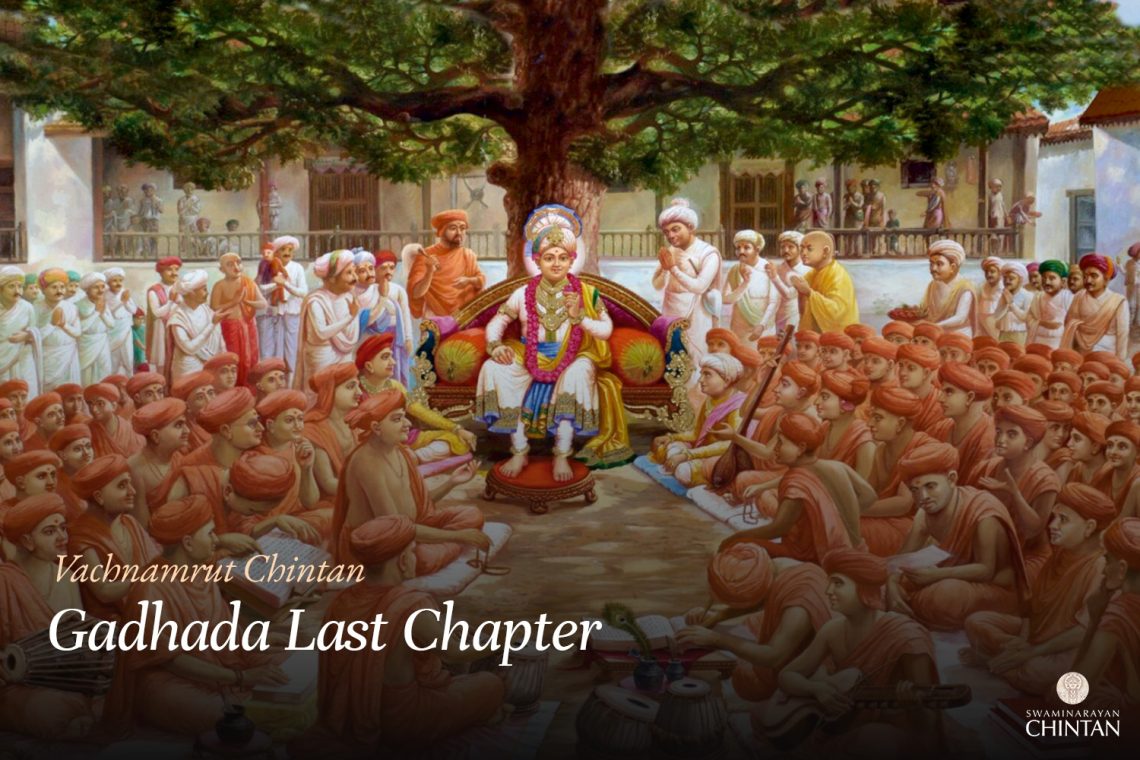Central Insights:
- The concept of Badhitanuvriti and the soul’s presence in the body.
Key Points:
- Badhitanuvriti is a minor shortcoming when seen from the perspective of the Nirvikalp (trance without self-consciousness) state.
- General devotees who fail to understand this process may perceive a great devotee’s behavior as flawed and thus commit sin.
- The soul resides in a mass of flesh (manas-chakra) but permeates the entire body through its general power.
Explanation:
This Vachanamrut focuses on Badhitanuvriti. Badhitanuvriti refers to the resurgence of thoughts or tendencies that were once suppressed or deemed false. Shreeji Maharaj explains that when a memory of an object, which had been dismissed as unreal, arises again in the mind, it is termed Badhitanuvriti. From the perspective of the ultimate liberated state (Purna Mukti), this is considered a flaw because, as stated in the Vachanamrut, it is destroyed entirely through Nirvikalp Samadhi. However, in the Savikalp (trance with self-consciousness) state, Badhitanuvriti persists and represents a minor shortcoming in spiritual steadiness.
For ordinary devotees, this state is still significantly elevated because Badhitanuvriti does not impede their progress on the path to liberation. Such devotees have surpassed many limitations and have ascended higher levels of spiritual consciousness. Maharaj warns that if general devotees misunderstand the reaction caused by Badhitanuvriti in others, they may wrongly criticize great devotees, causing harm to themselves.
Shreeji Maharaj remarks that a devotee of God might, through the power of Gnan (knowledge), Vairagya (non-attachment), and reflection, overcome worldly attachments. Yet, in the Savikalp state, a subtle fear might remain: “What if I still harbor a bond with worldly objects like wealth or family?” This is comparable to a warrior who has slain all enemies but remains fearful that some might revive. Similarly, a devotee might internally reject the world as false but, due to Badhitanuvriti, occasionally remembers wealth or other attachments, causing anxiety.
When such devotees face extreme physical weakness or their final moments, Badhitanuvriti might lead to memories of objects other than God. At such times, they might utter seemingly irrelevant words like “Oh my father!” or “Oh my mother!” A person ignorant of the concept of Badhitanuvriti might misunderstand this behavior, criticizing the devotee or losing faith in the path to God. They may think, “If even such a great devotee can behave this way, what hope do I have?” This lack of understanding harms both their faith and spiritual progress.
Maharaj clarifies that even sinners who leave their body while speaking or moving do not attain liberation simply because they remain conscious at death. Liberation is only assured for a devotee of God. Whether such a devotee passes away while consciously chanting God’s name or in an unconscious state due to Badhitanuvriti, they undoubtedly reach God’s lotus feet.
Shreeji Maharaj then posed another question to the senior saints:
“How does the soul remain in one place within the body while simultaneously pervading the entire body?”
When the saints were unable to answer, Maharaj provided the explanation:
In the body, food is digested and refined into semen. Similarly, the five basic elements of the body undergo refinement to form a specific muscular complex in the heart. This is referred to as the manas-chakra (anahat chakra in Yoga Shastra). This chakra is not geometrically circular but represents a cluster of flesh refined from the five elements. The soul resides in this manas-chakra.
Maharaj offered an analogy:
When a piece of cloth is soaked in oil and set alight, fire clings to the cloth. Though the cloth and fire are distinct entities, the oil (serving as fuel) allows fire to permeate and adhere to the cloth. Similarly, the soul, bound by past karmas, adheres to the manas-chakra.
Another example: When an iron nail is heated to red-hot, fire pervades the nail. Similarly, the soul resides in the manas-chakra, pervades the flesh, and, through its general power, animates the entire body. This allows the soul to experience bodily sensations like pain and pleasure.
As long as the soul identifies with the body, it experiences all bodily emotions as its own. The Antaryami (God as the inner witness) ensures the soul reaps the fruits of its past karmas, even if the soul resists.
Maharaj compares the soul to a lamp in a temple: the flame stays fixed in one location, yet its light spreads throughout the temple. Similarly, while the soul remains in the manas-chakra, its power pervades the entire body. The soul is inherently blissful and self-luminous. God, residing as a witness within the soul, administers its karmic fruits and grants liberation to those devoted to Him.
Glossary
| Bãdhitãnu Vrutti – Resurgence of suppressed tendencies The reappearance of thoughts or tendencies previously dismissed as false, seen as a minor flaw in spiritual steadiness. |
| Nirvikalp Samadhi – A state of perfect absorption or concentration where the mind is undisturbed It is a state of meditation where the individual’s mind is fully absorbed in the object of meditation, without any distractions, and free from worldly attachments. |
| Savikalp Samadhi – Trance with self-consciousness A state of spiritual meditation where awareness of self and subtle attachments may still persist. |
| Manas-Chakra – A refined cluster of flesh in the heart |
| Gyan – Knowledge |
| Vairagya – Detachment From Everything Except God |
| Antaryami – Inner controller The omnipresent form of Bhagwan that resides within all living beings. |
| Karmas – Actions and their consequences |
| Anahat Chakra – Heart center in Yoga philosophy |
| Moksha – Salvation The ultimate liberation of the soul from the cycle of birth and death and reaching divine abode of God |
| Purna Mukti – Ultimate liberated state |
| Karmic Fruits – Results of past actions |

